Today marks the 25th anniversary of the theatrical release of Back To The Future, a movie (and eventual film trilogy) that had a large hand in introducing the concepts of time travel, alternate realities, and hover-everything to today’s 20 and early-30-somethings.
The anniversary itself affords a rare opportunity to revisit the film and its sequels. Do they still hold up through the lens of adulthood? Can their complexity hold a candle to other time travel stories? Are they still entertaining?
Perhaps most importantly…will these films have the same impact on younger generations in the same manner that they did for mine?
The last question in particular made me curious. Luckily, I have a young niece with a growing hunger for science fiction and little to no exposure to the films. It was time for a re-watch of the trilogy. I would be reliving my childhood, she would be experiencing it fresh. I was surprised by both of our reactions.
For the record, my young relation was born in the mid-1990s and is still a minor, so we’ll be calling her “Spike” for the purposes of this post. (Also, her schoolmates call her that. I dare not inquire as to why.)
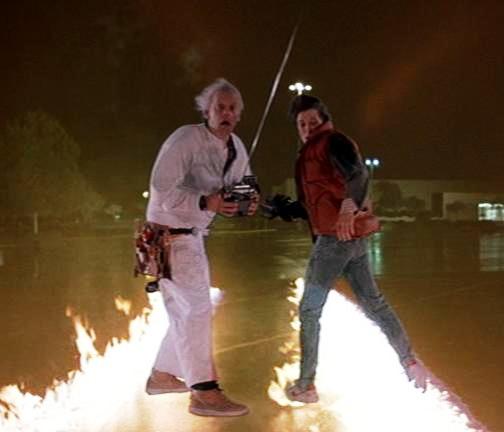
Back to the Future Reactions
Me: As a kid, I was enraptured by everything leading up to Marty’s trip back to 1955. Doc Brown’s lab/garage in 1985 is insane and the time machine even more so. I had no trouble accepting the main characters in Marty’s pathetic life, from Strickland to George and Lorraine.
The general urban decay of Hill Valley didn’t register with me then, so the impact of a cleaner, more prosperous 1955 Hill Valley was a little lost on me. Ultimately I remember being really bored by the 1955 setting in general. As a kid I had no way to relate to those surroundings and was too busy trying to figure out my own time to be curious about other decades. The ending of the film stretched forever in my memory, the tension making it seem ages longer than it was.
And, of course, the very last scene blew my tiny little mind.
As an adult I am astounded by how broad the acting is. Every line is played at 200%, eyes wide, gestures grand, as if everyone is convinced that they will never act again. This movie could have easily been a completely ridiculous affair if it weren’t for Christopher Lloyd. Dr. Emmett Brown is the broadest character of them all, but as a mad scientist he’s supposed to be, and this makes everyone else seem thankfully muted by comparison.
The 1955 setting is far more interesting to me as an adult, considering the established urban decay of 1985 Hill Valley (knowing that Doc Brown’s gorgeous estate gets turned into a commercial strip adds a touch of heartbreak to the otherwise light opening). “The Power of Love” doesn’t age well, neither does the “Johnny B. Good” run-through at the end, although it’s fun being able to realize how much Marty apparently loves The Who.
The Libyans? Plutonium theft? The brief moment of false tension where the red-headed guy cuts into George and Lorraine’s first dance? Don’t stare too hard at those plot points.
Marty’s 1985 family makes less sense to me now, although they make a larger emotional impact. In the beginning of the movie, Lorraine is an alcoholic and George is completely self-contained and withdrawn, but I understand how they got there in ways unfathomable to an adolescent. Even if the whole “type my reports, McFly” thing doesn’t quite make sense.
The 1955 versions of these characters are pretty precarious this time around. Lorraine’s character is barely sketched in, her primary task being to fall in ill-considered love with the greasy, unappealing George McFly. Her attraction to Marty is understandable, but the reasons given for her attraction to George are a bit disturbing. In the original timeline she mothers him until she loves him. In the new timeline she exalts him as her savior. The whole point of the movie is that George and Lorraine are OTP, but neither character is given a choice in this matter and I started wishing that the movie had played with that a little bit.
The broadness of their characters is meant to spackle over that inconsistency, but it’s harder to forgive the same from the character of Biff. It’s exceptionally hard not to think about why he’s not routinely arrested for his wideawake insanity. Also, wow, it astounds me how as a kid I never realized that Biff is attempting to rape Lorraine at the dance. WTF movie?
In total opposition, the character of Doc Brown benefits handsomely from the broad nature of the script. He moves the plot along and provides much of the comic relief, a tricky role to pull off in any regard, and his idiosyncrasies just seem to get more interesting when re-watching as an adult. Christopher Lloyd plays 1995 Doc to a spastic hilt and the detail with which Lloyd imbues the character is like a movie in itself.
The final scene still blows my mind. It always will. Although, knowing what I do now about how much sci-fi authors make, I have no idea where first-time novelist George McFly’s money comes from.
Spike: Spike, I think, enjoyed this movie more than I did as a kid. She is already familiar with the idealized commercial version of the 1950s that Back to the Future presents and has no trouble accepting and exploring it. Additionally, the “present day” action gave her a revealing glimpse (one perhaps more truthful than was intended) of a decade she never experienced. When “The Power of Love” cranks up in the opening sequence and Marty starts skitching, she burst out laughing. Marty’s dream Jeep elicited the same reaction. What was once the height of coolness when the movie is released is now just ironic.
She was also very pleased that the first time traveler in recorded history was an adorable doggie named Einstein. That was something I never considered myself, but in a present day full of Lolcats and Goggies it seems apt. She was also very surprised to learn that the DeLorean was a real car that existed for real in the very real 1980s, but had no context with which to grasp the in-joke of Doc using what was considered a lemon as a stout time-traveling vehicle.
“The Libyans!” threat made no sense to her, but she was cool with the plutonium theft. When we finally get to see 1955 in full view, Spike got wrapped up in the low-tech presented at Lorraine’s house and didn’t care so much for the humor being presented through Lorraine’s awkward advances.
Interestingly, she didn’t really take to the Doc until we meet him in 1955. When he’s first presented in 1985 he’s a good deal more subdued and it’s not until 1955 that we get to see him be warm and supportive towards Marty/Future Boy. Some of the Doc jokes went over her head, like his assertion that the 1980s is recovering from “atomic wars,” or Doc’s riff on Reagan. Doc’s aforementioned spastic nature more than made up for this, however, and he quickly became her favorite character.
The ending of the movie couldn’t quite hold her attention. The dance came off as too obvious a plot machination to really worry about and Marty’s clock tower race was much the same. There was never any question that Marty wasn’t going to succeed in getting back to the future.
The movie did succeed in faking her out with Doc’s shooting in 1985, however. As the action winded down, she remembered that she had already seen Doc’s fate and that Marty hadn’t succeeded in warning him. (Of course, she was super happy when it turned out he had.)
I’m happy to report that the final scene blew her mind, as well, and that the line “Roads? Where we’re going we don’t need…roads” lands spectacularly regardless of generation.
When we finished the movie, I said something along the lines of, “Just wait, Spike. You haven’t seen anything yet.”
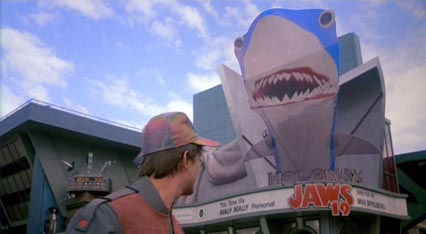
Back to the Future II Reactions
Spike: Except, actually, she has. Her generation has grown up seeing the armies of Mordor swarm outside of Minas Tirith, watched as the Doctor tied time in knots, read of alternate realities where history leaned this way or that, and experienced true horror as madmen brought down the World Trade Center towers and plunged world governments into rampant paranoia.
The 2015 in Back to the Future is brighter than the one she knows she will inherit. The economy is stable, the surroundings are peaceful and bright, and fusion energy is cheap and plentiful. It is also less advanced in some ways. The internet doesn’t exist in 2015, there’s no portable media, and the data and images we produce in real life are far more detailed and vibrant. (We also don’t have fax machines all over the house.) It’s cool that things hover and cars fly (and it’s VERY cool that the DeLorean flies) but she sees that concept with more of a Segway level of excitement. It’s neat, but impractical and less efficient than what we already have.
The seemingly post-apocalyptic 1985-A is good for a cheap shock in Spike’s case, but again the real world encroaches on this. The BP oil spill, devastation in Haiti, house foreclosures…Biff’s version of Hill Valley pales against this.
Marty going back to 1955 to weave in and out of his own timeline from the previous movie? She’s seen that kind of device in television and movies already, as late as last week, even.
Spike is bored by Back to the Future II.
Me: Which I can’t believe. As a kid, this movie delivered an addictive version of the then-far future in its first act, then got dark and twisty. Its pace was relentless and the concepts expanded my imagination in regards to just what you could do with time travel. Things could get seriously complex, and seriously fun. I’m crushed that it can’t have that impact anymore.
Granted, as an adult the movie’s version of 2015 doesn’t hold up so well. Much of it seems antiquated, although I did find it funny that its prediction of the Cubs sucking still holds true. Alternate 1985 is a bit painful to watch now, as its impact naturally diminishes upon repeat viewings, although our second run through 1955 still works pretty well. I felt myself wishing there was one less reversal with the whole sports almanac chase (did we really need the whole Strickland’s office bit?). The ending during the storm is still exciting, though, even though you know Doc’s about to get struck by lightning.
I wish they hadn’t tacked on a trailer for Back to the Future III into the movie itself, though. It deflated all the anticipation I would have had for the third installment (as it did when I was a kid.) Although, as a kid, the odds were stacked against the filmmakers here. They had just shown me the future and alternate timelines. How could a western stand up to that?
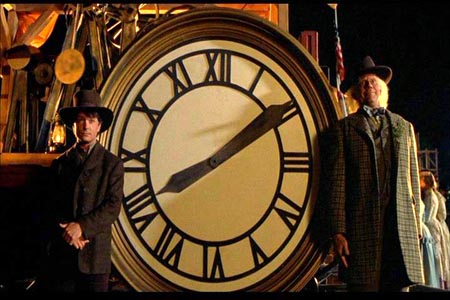
Back to the Future III Reactions
Me: Not well at all. I was extremely bored by this film when I was young. The beginning bit in 1955 was diverting enough, but after so many fake-outs in the first and second movies I couldn’t get excited by the possibility of Doc’s death, especially from a lame cowboy with a tiny gun (over a matter of 80 dollars!)
Perhaps unlike the other films in the trilogy, the third film ages fairly well. I certainly don’t mind watching a time-traveling western these days, although the setting of Hill Valley in 1885 doesn’t mix well in my head with westerns like Deadwood. It’s fun watching Doc invent basic comforts, harkening back to his experiments from the first film, except now with a newfound technical and emotional maturity. The role reversal between Marty and Doc also provides an emotional peg to hang your hat on that the second film was mostly lacking.
The adult in me has to chide 1885 Doc for lack of cleverness in resolving the gasoline situation, though. Gasoline had already been refined from oil by 1885, and California and the southwestern U.S. did not lack for oil production at that time. The Buford Tannen problem could have been solved simply by skipping town.
But then, you know, there’s no movie. And no spectacular train crash, and no terrific save via hoverboard. And no surprise steampunk time machine.
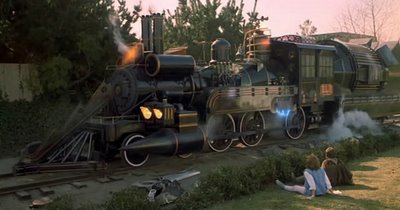
Doc’s time traveling train (that flies!) wowed me as a kid and still wows me as an adult. Look at that thing! It’s sleek and ingenious and homey and a train and it flies. I was and am still disappointed that there was never a fourth movie.
Spike: Spike enjoys the movie a great deal more than I did as a kid. It helps that this is a Doc-centric movie and that this series has consistently paid off for her when it explores the past. The character of Clara was a dud for her, but that’s to be expected in a movie series that mostly ignores its female characters.
The steampunk train was a last great surprise for her, as well, although she was a great deal more accepting of the end of the story than I was. The three movies hang together well as a whole, and since she got to see them all at once, it felt like a more complete experience.
I can’t believe it’s been 25 years, and that in another 5 years these films will run out of future to go back to, but I’m very glad to see that they can still hold up to new and old audiences alike. It’s difficult to realize that some key moments of wonder are now lost, but the oddness and whimsy of the series as a whole is still strong.
What have you found while re-watching these movies? Something similar? Something different? What jumps out at you years later?
Chris Greenland thinks the hover-laptop isn’t such a bad idea. Geez, these things are hot.










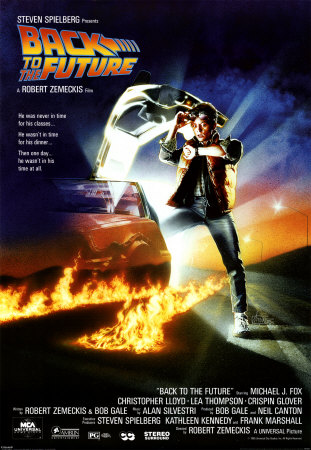
Wait, there really was a DeLorean? I lived through the 80s and had no idea! I’ve only ever heard the name as a reference to time travel. (It’s true that in the 80s I wasn’t paying any attention to cars, but still!)
I still love these movies. Growing up, the Back to the Future series was second only to the original Star Wars trilogy and we had them on constant replay during summer breaks. I can say they had a permanent impact on my subconscious–I still have frequent dreams/nightmares that involve alternate dimensions and time travel.
I caught part of BttF II and III on TV a few weeks ago. I was pleased when my number-obsessed son, who is five and autistic, seemed to enjoy it; he normally doesn’t like movies with live actors (or dead ones). After a few commercials, though, I realized the truth: he loved watching because they kept showing the Roman numerals in the movie titles. Sigh. I’ll keep trying.
@1 aedifica Indeed! The car was named after its creator, John DeLorean and it made a brief splash in the late 70s before the company went bankrupt. There’s a pretty cool rundown of dud cars here:
http://www.time.com/time/specials/2007/article/0,28804,1658545_1658533_1658525,00.html
I think it’s the doors that make it look so science-fictiony (they’re really pretty cool). Thanks for the link, greenland @@@@@ 3! And if only 8,500-some were made, that helps explain why I’d never heard of them elsewhere.
The DeLorean is the coolest car ever to exist in the history of the world. Ever.
By the way, I so totally own this tee: http://www.darkbunnytees.com/movietshirts/tshirts/BacktotheFuturemovietshirtladiesfit.html. I wear it to work all the time and am flabbergasted as to how many people don’t get it.
I’ve never seen the BTTF movies. Did I really miss anything? (I missed ET and Tron, too — I was in university and they just looked like movies for kids. Loved Blade Runner, though.)
Steven Jacques Roby @@@@@ 6: Your shame must be remedied ASAP. I suggest a midnight movie screening with as much food, beer, and friends as possible.
The Delorean was actually built in Northern Ireland.
It’s really sad when one dystopian vision of the future looks better than the present…
There was actually a slightly different vision when the first movie came out but, if memory serves me right, the studio insisted 2 and 3 get filmed together to save money.
Yes, the Delorean was a real car. It came out to a lot of accolades but no one was willing to buy it and it folded pretty quickly. The joke was that it was marketed as “the car of the future”, which was why it was so funny to use in the movies.
My favorite was always the third one. I blame the train and a hidden love of westerns that wouldn’t truly manifest itself until my early 20s (I’m now at the midpoint of 25).
Part 2 doesn’t hold up as well at all but that’s the problem with going to the future in your lifetime. Well, trying to imagine future tech period gets that way. I mean hell, Star Trek gave us flip phones that are ridiculously more advanced and now we have iPhones and Droids that can do video calls. Anyways, the sleekness of the cars still sits well but the ridiculous Jaws hologram and Max Headroom-esque celebrity waiters is pitiful. The clothing (on way-pre-Frodo Elijah) harkens back to some of the silly futuristic visions from the 50s but with 80s neon colors.
There are a few things in Part 2 that either held up well or that I sincerely wish were up and running or on their way. Firstly, Griff having cybernetic implants, albeit, albeit souped up. That still holds up nicely, even if we haven’t cyborged people’s strength yet. Secondly, MR. FUSION! I love the whole bloody concept of Mr. Fusion and wish to hell that a similar concept would arise for powering pretty much everything that needs powering, especially cars (yes, I know it powered the time circuits, not the actual car but run with it). Thirdly, power laces. Tell me those wouldn’t be awesome to have. Just try it. Although, 25 year old me did begin to wonder something related to power laces: Why do we have velcro shoes so much? They’re futuristic, more efficient and easier to maintain than laces. Food for thought.
Ultimately, like most things set in the not so distance future (and in some cases, the distant future), it has it’s up and downs here, especially being so close to the actual future at this point. And you can say what you want but I still love “The Power of Love”.
You seem to forget that we do have hoverboards nowadays.
http://www.futurehorizons.net/hoverboard.htm
Not quite the same as in the movie, but these have been around for some time now and were used in the 2000 Summer Olympics in Sydney, Australia.
And just in the last few years, the Flying Car is coming of age.
http://www.terrafugia.com/
It’s amazing how technology eventually catches up with sci-fi.
This was a great experiment. I’m glad the movies still hold up for younger audiences, because you never can tell how something you loved as a child will be received by later generations. I’ve been planning to re-watch these for a while. The last time I watched them all in a row over three evenings (ironically on laserdisc, considering laserdiscs are filling dumpsters in 2015 in BttF2), I loved them just as much as I did when I was younger, and found a new appreciation for the underrated Part 3. Most of all, I liked how it really feels like one story, with all three films linking up much better than you would expect and lots of in-jokes that may only be noticed on repeated viewings.
Let us know how you do with the re-watch of the animated series…
In the future please don’t assume that your readers will know what things like “OTP” mean.
Hoverboards? Flying cars? People can barely hold a cup full of hot coffee at Starbucks without dumping it on their baby and you want them to have a futuristic way to maim people? The skateboards with wheels are bad enough, could you imagine the faceplants possible with hoverboards?
I haven’t rewatched these in a long time… But I expect I’d still love Huey Lewis. ;) I didn’t remember liking II when I saw it first, and haven’t rewatched it. My memory is that it was needlessly obtuse; and nasty emotionally and thus missed the emotional tone of the 1st and 3rd. But it’s been long enough to give it a second shot.
EvanH: GIYF.
Hmm. I’ve always enjoyed the first and third movie over the second – the weaving of the plot of the second film with the first never did much for me… although I see it as necessary for the plot to give Marty his ‘chicken’ problem that he didn’t have in the first film.
I’m glad Spike enjoyed them!
@ecmyers I am SO glad you mentioned the animated series!
FYI: Blu-Ray box set is coming out in October. I am more than pumped.
These movies are my childhood.
@17 Jordache
I have some episodes of the animated series on laserdisc too :) Bill Nye the Science Guy!
Must re-watch!
I remember re-watching them when I was somewhat older than my first viewing and suddenly realising that what Doc shouts in the car park is “Libyans!” Up until taht point, it was a random nonsense word to me – I must have been young enough to have no knowledge of world affairs and foregin countries outside the obvious few when I first saw the films. It was a bit of an epiphany!
I always liked the third movie a lot more than the second, which did strike me as odd even at the time, because the second movie had all the time travelling and the paradoxes and whatnot, so how could a western be so much more entertaining?
I think the problem are the Tannens. They’re boring. They’re the same from 1955 to 2015, so hey kind of fail as a compelling big baddie.
By the way, Telltale Games recently got the license to make a BTTF videogame. I hope they can work the same magic on this series that they did for Sam&Max and Monkey Island, without too much interference from the studios.
Since I got the Wii Balance Board, I keep thinking of that line from BttF II when Marty shows the kids the old arcade game: “You mean you have to use your hands?!”
(Also, OMG @Ashe Armstrong , I didn’t realise that was Elijah Wood!)
Mixing a little Fantasy with our SF, it is said that the DeLorean failed because they destroyed a hawthorne tree to build the plant in Belfast, angering the fairies.
As someone who never saw the eighties I grew up loving this trilogy! My sister and I watched them over and over and we built countless train tracks leading to the stairs so we could reenact the train blowing up in the canyon.
We usually watched the whole trilogy right in a row, (well, sometimes we would just skip the second so we could get the third one quicker). The third was always the best in my eyes, mostly because of the interactions between Doc and Marty and just how much FUN it is. I will always remember the line where Marty says “Great Scott” and Doc says “This is heavy.” =D Just goes to show how far they’ve come together.
Btw: I’ve been dying of curiosity my whole life to imagine what growing up on a flying, time-travelling train would be like for those two kids. Now there’s a story.